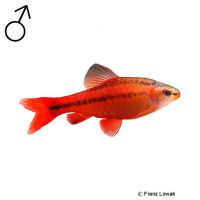Red Cherry Barb (Puntius titteya 'Red')
| Red Cherry Barb Puntius titteya 'Red' | |
|---|---|
| Name | Red Cherry Barb |
| Name Lat. | Puntius titteya 'Red' |
| Synonym | Barbus titteya |
| Family | Carps |
| Family lat. | Cyprinidae |
| Order | Carps |
| Order lat. | Cypriniformes |
| Origin | South Asia |
| Habitat | Tributaries, forest streams |
| Diet | Omnivore |
| pH | 6.0-8.0 |
| Behavior | Peaceful |
| Keeping | Group |
| Care Level | Easy |
| Reproduction | Egg scatterer |
| Breeding | Moderately difficult |
| Life Span | 3-5 years |
| Protection | No |
| Metric Units | |
| Size | 4-5 cm |
| Temperature | 20-27 °C |
| Hardness | 5-20 °dH |
| Aquarium | ~ 80 l |
| US Units | |
| Size | 1.6"-2" |
| Temperature | 68-81 °F |
| Hardness | 89-356 ppm |
| Aquarium | ~ 20 gal |
Distribution and habitat
The red bitterling barb is a breeding form. The distribution area of the wild form is waters between Kelani and Nilwala River in Sri Lanka. They live mostly in the shallow margins and stillwaters of tributaries and forest streams with roots, foliage and dense riparian vegetation.
Maintenance
The aquarium should have a dense border planting, with hiding and retreat possibilities (roots, stones) and offer sufficient swimming space. With slightly shaded light (floating plants) and a dark substrate covered with some foliage (e.g. sea almond leaves) they show the most beautiful coloration.
No ammonia, ammonium and nitrite should be detectable, the nitrate value should not exceed 100 mg/l. To ensure the water quality and oxygen content, a filter and heater adapted to the aquarium size is required, as well as lighting for the species-appropriate day-night rhythm of the animals.
Diet
In nature they feed on small crustaceans, algae and detritus. The food offer consists of live food, which is accepted without problems also in frozen form, supplemented with frozen food mixtures. Especially daphnia, artemia and red mosquito larvae must not be missing. In addition, they regularly need vegetable food, such as algae leaves, crushed peas, mashed leafy and wild vegetables or dry food (flakes, granules) with high vegetable content (spirulina, kelp)
Only feed as much as will be eaten within a few minutes. A regular and varied diet promotes health and increases resistance.
Behaviour and compatibility
They are lively but very peaceful schooling fish that can be socialized well with other peaceful fish. At least 5, but preferably more bitterling barbs should be kept together
Basically, only compatible fish species with similar requirements for water conditions and water temperature should be socialized.
Sex dimorphism
Males are intensely red in color and more slender than females.
Reproduction and breeding
They are free spawners that do not engage in brood care. The male usually swims around (drifts) the female in the early morning, which spawns among fine-feathered plants. The larvae hatch after about 24 hours and swim freely after a week.
Fry must be fed several times a day with special rearing food (Artemia nauplii). In community tanks breeding is hardly possible, because the spawn is easy prey.
Important
Bitterling barbs are bred in several color varieties.
The foliage (e.g. sea almond leaves), when rotting, promotes the development of microorganisms, which are a valuable secondary food source
The well-being of the fish should be monitored regularly. Temperature should be checked daily, pH, hardness and nitrate levels should be checked at least every 14 days. Regular partial water changes are recommended, even when contaminant levels have not yet reached the upper limit. Sudden changes in water quality should be avoided. Newly introduced fish must be accustomed slowly to the water in the aquarium.
Further literature can be found in your pet store.
References
Text: Werner Winter; Image: Franz Lowak
Source: BMELV (1998): Tierschutzgutachten - Haltung von Zierfischen (Süßwasser); RIEHL & BAENSCH (2006): Aquarien Atlas Bd. 1, Mergus Verlag; ENGELMANN (2005): Zootierhaltung - Tiere in menschlicher Obhut: Fische, Verlag Harri Deutsch
- Gemäß § 21 Abs. 5 Tierschutzgesetz idgF
